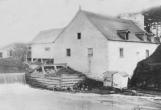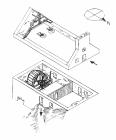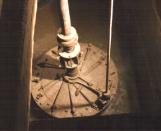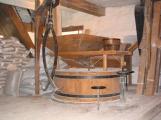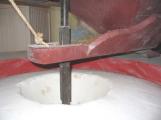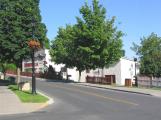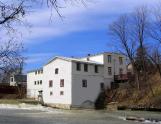1
The mill's technological evolution is comprised of two completely separate phases, each of which lasted 120 years; the first phase extended from 1762 to around 1880, through the years when the paddle wheel operated, whereas the second phase covered the period when the turbines were in use.Traces of the mill's first phase can still be seen today. On the north wall, which faces Saint-Eustache street, one can still see the two homes of the miller's first residence. Originally, these lodgings rested directly on the roller. Above it, on the northern gable, there was a door where the farmers entered with their sacks of grain. Of the four beams that supported the ceiling of the ground floor of the miller's house, there remains only one, as the others have been cut down.
The original mechanisms, including the large, vertical sheave, the two lanterns and the small stone saw, were placed on the ground floor, but were originally one metre lower than they are today. As for the millstones, they were situated on the attic floor and supported by two enormous beams that have since been raised.
3
According to the current hypothesis, the farmers brought in pockets of grain through the door placed at the level of the attics, which opened out onto Saint-Eustache street. As they unloaded them into the hoppers, the grain was then ground up by the millstones located on that level. Then the flour was sent down to the lower floor, or the transmission floor. The farmer then picked up his pockets of flour through the door in the east wall, which is the current entrance to the mill.6
Charles-Auguste-Maximilien Globensky had the turbines installed inside the mill around 1880; which led to the second phase of operation. As they saved a lot more energy and were especially a lot more powerful than the former bucket wheel, the turbines allowed for a considerable increase in wheat production.The placement of the turbines made a lot of free space available: the millstones were then brought back down to the ground floor, and were set closer to the turbines that operated them. Thus, all of the mill's operations were directed from the ground floor. That explains in large part why the miller's house, built in 1902-1903, was erected on the attic floor.
Around 1880, a sawmill was installed in a building that was perpendicular to the flour mill. Built from balloon framing and laid on piles, it used the energy provided by a turbine. However, its machinery has almost completely disappeared, as only a few mechanical traces remain.
12
Form and functionRectangular in shape, the flour mill presents features from vernacular architecture inherited from French traditions. It is different than a house, due mainly to its right-angle position with respect to the river. It has no particular style, but instead an architectural tradition.
The sawmill presents several traits that are similar to vernacular architecture. Purely functional, it is similar to farm buildings such as barns or stables. Its slanted, two-sided roof was replaced in 1919 by a lean-to roof.
The house, built in 1902-1903, is of the "boomtown" style. Contrary to the surrounding buildings, it shows several decorative elements, in particular a molded fascia, window frames and decorated door jambs. Viewed from Saint-Eustache street, the mill appears to date from the turn-of-the-20th Century, whereas viewed from the Chęne River side, it appears to date from the 18th Century.
